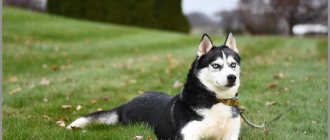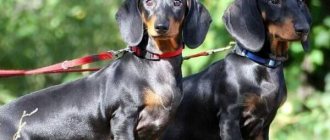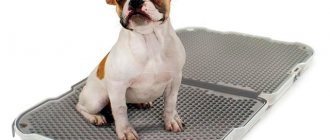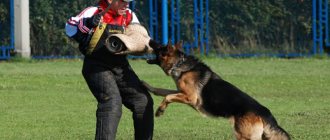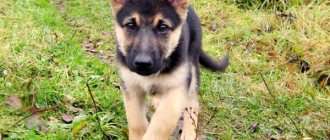This dog breed was originally bred by breeders to hunt foxes. The elongated body and short legs served it for unhindered penetration into burrows and chasing predators through the thicket of the forest.
Today, the dachshund is considered one of the most popular varieties of domestic dogs. The breed is characterized by a good-natured disposition, devotion, submissive character and a sensitive sense of smell.
Veterinarian advice. Special wintering conditions for dogs
According to weather forecasters, the winter will be cold, with sharp temperature changes. Caring owners should worry in advance about preparing their four-legged friend and guard for the winter.
Larisa Martynova, a veterinarian at the Aibolit+ clinic, told us how to do this correctly.
Before frosts and in the spring, be sure to wash the booth and treat it against ticks with special preparations. The area around the booth must be kept clean and, if possible, regularly dug up.
The booth can be insulated with a layer of polystyrene foam 5 cm thick or upholstered with a blanket. However, the insulation must be covered from the inside - preferably with a sheet of plywood. Otherwise, dogs can crumble it, and this small litter will be a real paradise for parasites. The size of the booth must correspond to the size of the dog, then it will be able to warm it with its breath. In the right kennel, even in severe frost, there will be a comfortable plus temperature for the dog.
To prevent the booth from being blown out (it’s not so much the frost that’s scary for dogs, but the draft), you need to curtain the entrance to it with thick material, preferably rubber. Then the dog will not tear it apart, as he does with fabric curtains.
Make sure that the floor of the booth does not freeze. To do this, do not place the kennel directly on the ground, but place wooden blocks or bricks under it. It is better to put straw inside the booth, not an old mattress or shavings. This will keep the dog warmer and cleaner (the straw needs to be changed at least once a month).
Keeping a devoted friend on a chain is extremely undesirable, especially in winter. In cold weather, the animal needs to actively move to avoid freezing. And the chain limits his freedom of movement.
In cold and hot weather, the dog spends a lot of energy maintaining normal body temperature, so special attention should be paid to feeding. If the animal is on artificial food, you should choose food marked active. If the food is natural, make it more high-calorie in winter with meat, offal, trimmings, and fish. There is no need to increase the frequency of feedings: feeding twice a day is enough.
Dogs suffer from viral diseases: for example, “kennel cough” is common. It is not associated with cold and usually develops in spring or autumn. If you notice that your dog is coughing, you should not let this disease take its course; you should definitely contact a veterinarian, because it can develop into pneumonia and lead to death. It is advisable and necessary to let puppies go outside in winter: to get some fresh air, and also for hardening purposes. In addition, snow brings them into real puppy delight. Is it possible to deprive them of such joy?
Source
First winter walks with a dachshund
If your dachshund puppy was born in autumn or winter, then the first walks will be during the cold season. Starting walks with a dachshund in winter is an adventure! Wink
So, all vaccinations have been completed, and it’s time for the puppy to start walking outside. Walking develops the puppy physically, strengthens muscles, hardens the entire body, improves blood circulation and the functioning of all internal organs. Walking always improves your dog's mood. After walks, the dog eats and sleeps better, the puppy makes his first friends and enemies on the street, his character is strengthened there, the process of socialization takes place, relationships are established with other dogs, with passers-by, with walking children, runners and cyclists. It is during a walk that a dachshund puppy will have to learn many different rules of behavior - how to behave on the road, how to treat various goodies that are lying right on the sidewalk, how to deal with cats, and so on.
If you happen to live in a city where it snows in winter, the temperature is consistently below zero, and the roads are sprinkled with salt, then this article is for you.
To help your Dachshund puppy develop a positive attitude towards walks and the outdoors, start gradually. First, carry the puppy out in your arms, walk down the street for 5-10 minutes, don’t put the puppy on the ground, just let him breathe in the cool air. After a few “tame” walks, put the puppy on the snow, let it stand for a minute or two, then pick it up again. Gradually increase the time your puppy spends on the ground. As soon as your dachshund puppy starts shaking, take him home. It will be better if you prepare your puppy for walks in clothes in advance. Put your puppy in overalls or other clothes at home, let him get used to it and run around the house like that. This will help him not to get confused on the street.
It is advisable for the puppy to move during a walk - run or at least walk, this will allow him to warm up naturally. But on the very first walks, not all babies can be made to be active - of course, there are so many new smells, sounds, objects, people and everything else around. Try to entice the puppy with a toy - let him follow it or you. Encourage him with kind words and cheerful intonations - most likely, the baby is not only cold, but also scared.
Gradually, the dachshund puppy will learn to run after its owner, walk on a leash, and even toilet outside! Cool
For walks, if possible, choose clean paths - without salt and dirt. Newly fallen snow will be the best solution. If absolutely everything is sprinkled with salt and reagents, you will have to buy shoes for the puppy. Otherwise, these chemicals can eat away at the puppy's paws until they bleed. When you meet another dog, do not rush to grab the puppy in your arms; as a rule, adult dogs treat puppies well. If someone else's dog is good-natured and radiates friendliness, let them sniff. If someone else’s dog behaves aggressively and does not inspire confidence, then it is better to hold the puppy in your arms for now - no one needs a conflict now, our goal is to form a positive attitude in the dachshund puppy towards walks. Gradually, your baby will learn to communicate with all dogs, but for now, don’t get scared again. If the puppy begins to show interest in something on the street, this is a very good sign, it means that he has almost settled down!
Don’t forget to put on a collar before going for a walk and start walking with your dachshund only on a leash - it’s hard to imagine what might happen on the street, but it will be better if you control the situation with a leash or tape measure.
Gradually increase the walking time from a few minutes to half an hour (see how the puppy behaves). After returning home, be sure to praise your baby publicly, let the whole family hear how great he is! This will give him confidence, and a positive emotional connection will be formed with the walk. It is recommended to walk Dachshund puppies after feeding so that the process of toilet training occurs easily and quickly. In the future, after a year, the dog should be fed after a walk. To learn how to toilet train a dachshund puppy outside, read the article “How to toilet train a puppy? Step two – we teach the puppy to go to the toilet outside.”
1. Start walking for a few minutes.
2. First, take the dachshund outside several times in your arms, without putting him on the ground, to get comfortable.
3. If it is very, very cold, wait until the frost drops to at least -10.
4. It’s better to dress the puppy so that he doesn’t get too cold.
Keeping at home
Its small size allows you to have a dachshund in a comfortable city apartment or private house. Before purchasing a puppy of this breed, prepare the place where it will live, and also require:
This breed is active, loves attention and affection, but does not tolerate interference in personal space, and all household members, including children, should know this.
Arrangement of space in the apartment
The dog definitely needs to create its own space (corner), where it will feel comfortable and where it will follow the owner’s command “Place!” The dachshund, like all short-haired dog breeds, does not like to sleep on the floor. Therefore, you need to buy a mattress or bedding in advance for the animal to sleep and rest.
The sleeping place must necessarily correspond to the size of the dachshund and the method of rest. If your dog sleeps curled up in a ball, you can buy an oval mattress; if his favorite position is with his legs outstretched, a rectangular bedding will do. The dimensions are 15 centimeters longer than herself, and the width is twice the size of a dachshund. Only in this case will the dog sleep comfortably on the mattress. As the animal grows, the bedding needs to be changed, buying larger sizes.
Preparing for the arrival of a dachshund puppy in the house
If you have decided to buy a dachshund for your apartment, then you need to prepare for the arrival of a new family member. To do this, you must follow these rules:
- Remove all hanging wires and breakable objects.
- Buy all the essentials for your dog.
- Clean the room.
- If there are other animals in the house, hide their bowls away from the puppy.
- Remove poisonous plants.
- Raise household chemicals and medicines higher.
How to properly care for a dog at home
The dachshund puppy (1 month old) does not like to be alone and therefore his sleeping place should be placed closer to his owners. But it is worth considering that the place to sleep should not be near a heating device or in a draft.
Important! To keep your dog comfortable, she needs to purchase a bed, a leash, a collar, food bowls, toys and a litter tray.
Proper care for your dachshund
Proper care of an animal is not only the correct diet, but also proper care of the condition of the body. There are plenty of nuances here, and future lovers of this breed should know them.
Ear and eye care
The eyes of this dog are protected by nature, namely by the structure of the muzzle. Thanks to their special shape, the animal’s eyes are to some extent protected from dust and small debris. But this should not be a reason for a complete lack of care for this part of the body. Like other dogs, they can get into various situations while playing on walks that can affect the quality of their vision, and these problems should not be allowed in dachshunds. Eye care tips:
The animal’s ears also need care; they should be periodically cleaned of street dirt and sulfur clots. Clean with a cotton swab, using cleaning products: “Polyseptin”, “Otoferonol”, “Bars”. You need to clean your ears only within sight, so as not to harm the eardrum, after first dropping a few drops of cleaning solution into the auricle.
Dachshund coat care
This breed of dog does not require special coat care. Regular washing and brushing is the optimal set of measures. You can bathe the animal itself no more than once every 2 months. And after a walk, wipe your dog’s paws with a damp cloth. This applies to smooth-haired breeds. During shedding, you need to brush a little more often to prevent clumps of fur from forming.
Dachshunds with long hair require longer and more frequent brushing. Be sure to do this after a walk to remove tangled grass and other debris from your body.
You need to keep in mind that dachshunds do not like to be groomed, so the owner will need to regularly reward her with treats or walks.
Dental care
Most health problems in dogs occur due to dental damage. The peculiarities of this breed are the knowledge of the world and everything around it through its mouth. They always have to chew on something, and this often ruins their teeth. You need to brush your teeth as often as possible using a toothbrush.
It is strictly forbidden to use toothpastes. It is better to do this with saline solution. The animal also does not like this procedure, so at first it is impossible to do without outside help.
Paw care
Some dachshund owners consider caring for their nails and toenail hair overkill. Too long claws on the paws, especially in small individuals, cause lameness. Long hair between them also interferes with the dog's walking.
To prevent these sad phenomena, both the claws and the hair on the paws need to be trimmed periodically. You can buy a nail clipper at any pet store. With its help, it will be easier to trim the strong nail plate on the dachshund's paws. They need to be trimmed at least once every 2 months.
What you need to know about the breed?
Those who just want to buy a dachshund or who already have one need to know the features inherent in representatives of this breed. Ignoring them can lead to immediate deterioration in your dog's health or even death.
Features of handling dachshunds:
- They must be protected from jumping from heights (even from the sofa);
- It is strictly forbidden to lift the puppy by the scruff of the neck;
- It is necessary to select dachshund companions (other dogs) who are not much superior in height and strength;
- Avoid situations where the puppy stands on its hind legs. This can cause spinal deformity;
- There is no need to smooth the ears, as this will cause them to droop;
- Before vaccination, it is prohibited to go outside with the puppy.
How often should you go for walks?
A Dachshund puppy should be walked as often as possible, as this will help make it clean, friendly and sociable. You need to take your dog out after waking up, before going to bed and 20 minutes after each feeding. An adult dachshund needs to be walked at least 3 times a day for 20-30 minutes . Games involving jumping are prohibited. The dachshund is a hunting dog, and therefore you should forget about quiet walks forever.
How often should I bathe?
You can bathe your dachshund at any age. To do this, you need to use baby or special shampoo. It is better to avoid rinse aid and conditioner. You should wash your dachshund using various means no more than once every 3-4 months . You can bathe her in plain water an unlimited number of times.
Choosing a collar
It is not recommended to buy metal collars for your dachshund - although they are reliable, they become a real torment for the dog, constantly squeezing its neck. It is also not recommended to buy collars that are too thick and soft. The best option for representatives of this breed would be a collar with a thickening in the middle , which will not rub or twist.
Features of care and maintenance of a dwarf (miniature) dachshund
This breed requires special attention. She does not tolerate loneliness, and even more - self-dislike, reacting sharply to this. A miniature dachshund without the required amount of walks can waste away right before our eyes. You should take care of her fur, ears, paws and eyes more carefully and more often. Smooth-haired dogs should be taken regularly to a dog groomer for grooming.
The situation is a little simpler with short-haired dogs - they can simply be bathed and combed, but more often than an ordinary dachshund. The breed is endowed with a sharp mind, it is overly curious, and lends itself well and quickly to training and education. In addition to communicating with her owner, she also needs to play with other animals.
Should we dress our dachshund?
This question is asked all the time, in different contexts and at different times of the year. A huge number of offers on the pet products market constantly prompts owners to think about the urgent need to use this element of dog care.
So let's figure it out: should we dress our dachshunds, how and at what time of year?
We will talk about dachshunds of all types of coat: smooth-haired, long-haired and wire-haired.
I set out to do a little research, measuring the surface skin temperature of all three varieties of standard dachshunds, at different times of the year, under different temperature conditions.
We will consider the ideal temperature conditions to be for the dachshund to be at home, at room temperature. (+20-22 C)
Hot summer is coming, our dogs accompany us on walks around the city, they live next to us in dachas and country houses. This period is characterized by a potentially dangerous increase in air temperature. All varieties of dachshunds react differently to increases in body temperature. When measuring the temperature of the skin, when the air temperature increased above +25 C, curious data was discovered that was absolutely not obvious to the owners:
It turned out that body temperature rises fastest in... smooth-haired dachshunds! The slowest ones are in long-haired, standard-haired dogs. However, to forcefully lower it (for example, by cooling it with a damp towel or sheet) is easiest for a smooth-haired dachshund, and most difficult for a long-haired dachshund. This fact, as well as the fact that the skin temperature of black and tan dogs in summer is 4-5 degrees higher than that of all others, must be kept in mind to prevent summer heat stroke.
In the spring and autumn periods of the year, dachshunds do not have problems with thermal discomfort. They do not overheat or overcool, because even the smooth-haired dachshund has a fairly dense coat. The question of whether a dog needs to wear a “raincoat” or a “mud jacket” is something every owner is free to decide for himself, based on his own conditions. A non-insulated, water-repellent overall that does not restrict movement can really make life much easier for owners. However, it is worth remembering that before the air temperature drops below +5, any overalls can significantly increase the dog’s natural body temperature.
Winter is coming. The air temperature is rapidly dropping, and the first snow is falling.
All varieties of woolly dachshunds cool down differently. Moreover, it should be noted that wire-haired dachshunds that are not trimmed can differ significantly from wire-haired dachshunds after a visit to the groomer, when almost all of the “warming” undercoat is removed from the dogs. Moreover, in winter you can observe a significant difference in the degree of cooling, depending... on the color. Black and tan dachshunds cool down more slowly than red, coffee and tan, and merle dachshunds. Dogs over 8 years old “cool down” faster than young ones, large ones - slower than small ones, thin ones - faster than fat ones. Puppies are much faster than adults. Standard dachshunds are slower than miniature ones.
The most “cold-resistant” are well-dressed, adult standard long-haired dachshunds (which is not surprising). They share this honorable first place with non-trimmed standard wire-haired dachshunds. Second place goes to trimmed standard wire-haired dachshunds, and smooth-haired dachshunds cool the fastest; the absolute “anti-record” is set by rabbit smooth-haired dachshunds.
Cooling dachshunds of different varieties at temperatures below -5 C:
The frosts are getting stronger, and we are increasingly seeing dachshunds of all stripes and varieties, sporting colorful suits of all styles and designs.
Let's take a look under these colorful outfits and see what the skin temperature of our dachshunds looks like in “thermal imager format.”
Pay attention to several interesting and very important points: when using insulated overalls, the dog’s body temperature increases. At the same time, the skin temperature increases in the most “problem” areas of the body, vulnerable to a significant decrease in air temperature: paws (in all varieties, least of all in wire-haired ones), “plates” of the ears (in all varieties, except long-haired ones) and tail (all varieties except longhaired ones). This occurs because “warmed up” blood is transferred by the bloodstream from the body to the periphery - to the paws, ears and tail. This tactic is completely justified for smooth-haired dachshunds. We see that the difference in skin temperature on the body and on the periphery is not great. However, already on wire-haired dogs (to a minimal extent on trimmed ones, and to a much greater extent on “full-haired” ones), we see a significant difference in the temperature of the skin surface. This effect reaches its maximum manifestation on long-haired dachshunds. The difference in their skin temperature can reach 10 degrees! A “sauna effect” occurs, which can lead to rather dire consequences. Serious stress on the heart, increased likelihood of colds and exacerbation of chronic diseases.
All this allows us to draw the following conclusions:
A smooth-haired dachshund may need overalls at temperatures below - 10 C
A wire-haired dachshund , at temperatures below -10 degrees, may really need a well-ventilated (preferably knitted) overalls, especially during the period after trimming.
Long-haired dachshunds with coats of the correct texture and volume of the breed do not need winter clothing. The exception is walking at temperatures less than -20-25 C.
At temperatures below -25 C, a walk for a dachshund of any variety should not last more than 15-20 minutes.
Old, pregnant, lactating dogs, as well as dogs with various types of chronic diseases, need additional ammunition, selected individually.
N. Koroleva Specially for “Dialogues about Dachshunds”. February 19, 2018
When using, references to the original source are required.
We share interesting things:
Mess
This “one and a half dog” has its own vision of comfort and a manic passion for destroying any things. The daily routine of an active dachshund must include something like “Tearing off outdated wallpaper” or “Crunching a cool thing left unattended.”
Forget that you had something of your own - your slippers, your child’s toys. Read the Dachshund Code and be horrified, because everything is now under constant threat. Everything that these attentive eyes see, what these greedy paws reach.
Photo: pixabay.com
The dog will treat soft toys with special trepidation and ardent love, either collecting them from his bed to pat them, or chasing them and throwing them into remote corners of the home. Once a toy's seam fails, its days are numbered. A curious long nose will methodically and even with some kind of furious passion dive into the hole in order to remove completely unnecessary filler from the toy. Of course, it will not go to waste and will festively decorate the floors in the rooms.
This fun involves a timely explanation of the fundamental difference between outerwear (the same down jacket) and a favorite, but considerably thinner toy. That this difference is not only in size. Well, it’s as if the dog isn’t stupid, really. This is especially felt when, with a businesslike look, she drags a screwdriver from a children's construction set in her teeth, stops for a second and looks into her eyes. In the look, complemented by the indescribable movement of the eyebrows - yellow dots, the question is clearly read: “How else can I help with the housework?”
Photo: pixabay.com
Concluding the review, I will briefly note the items that owners who are poorly versed in entertainment usually regret the most. Shoes, all kinds of wires, books, money, furniture, baseboards, wallpaper, clothes and bed linen.
All about dachshunds: how to feed
You need to feed your pet, first of all, meat: beef, pork, chicken, lamb. Dachshunds enjoy eating fish. Under no circumstances should you give these dogs bones! They have no nutritional value, but both teeth and intestines suffer. Cereals, as a source of carbohydrates, will also be beneficial for dachshunds. Don't forget about vegetables and fruits. As additional nutrition, you can use dairy and fermented milk products, seafood, baked goods, etc. Attention! You should not overfeed your Dachshund as this can lead to obesity, which will increase the stress on the spine and may cause injury.
Can a dachshund live outside in winter?
If you have decided to buy a dachshund puppy, then you should remember that this animal is not suitable for living on the street. Therefore, when asking yourself the question of how to care for a dachshund on the street, you should even think about whether to choose a different breed. This animal tolerates both cold and heat equally poorly due to its special body structure.
This dog is very active, and restrictions on walking can be disastrous for it. Therefore, no matter what the weather is outside, you need to walk your dog in the yard for as long as possible. However, leaving it outside permanently is prohibited.
Training your dog to be home alone
This is one of the important points in education. If you don’t train your dog to be alone at home, then it will constantly wreak havoc in your apartment, chew off the wallpaper, and squeal all day long, disturbing the neighbors.
Education begins with the command “wait”
It is necessary to begin education with the command “wait”. But before you leave, it is important to make sure that the dog still has toys and some things with the owner’s scent.
Important! Caring for a dachshund is equivalent to caring for a small child who constantly needs attention and does not tolerate the absence of his “parents”.
Litter box training and walking
Chihuahua: care and maintenance at home
It is necessary to accustom your dachshund to the tray from 1 month. If there are carpets in the apartment, then it is worth removing them for a while so that they do not smell like urine while the puppy is still getting used to going to the litter box.
To speed up this process, you need to start with diapers, which are sold at any pharmacy. They do not allow moisture to pass through, and they do not smell like urine. At first, the baby will ignore trips to the diaper, choosing some secluded corner in the house, but you should not punish him for this.
Tray training a dog
In the resulting puddle, you need to moisten a small piece of cloth and put it under the diaper, and wash the place where the puppy relieved itself with a soapy solution using vinegar. After performing this manipulation several times, you can quickly accustom your dachshund to a diaper, after which it will also go to the tray.
As for walking, you need to walk your dog as often as possible. Be sure to take him out in the morning and evening and walk for at least 30 minutes. Since this dog is quite active and energetic, you should walk it on a leash so that it does not attack some large dog, thus ending up in an unpleasant situation.

